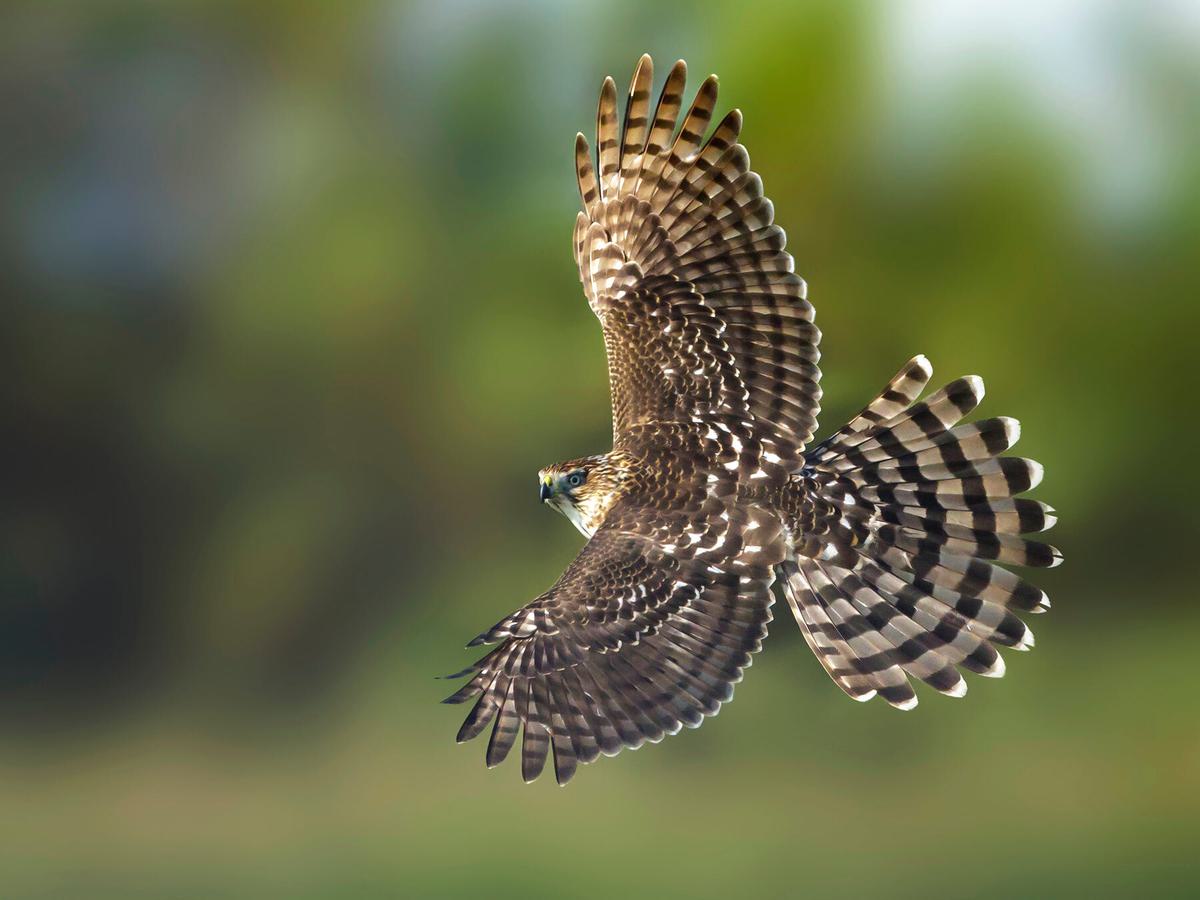Jump to Section
Juvenile Cooper's Hawks (Identification Guide with Pictures)
Last updated: 23 August 2022

A Cooper’s hawk (Accipiter cooperii) is considered juvenile between the nestling period and reaching sexual maturity, which can last between 18 months and 3 years. They can hunt, fend for themselves, and are no longer dependent on their parents. However, a juvenile is not yet old enough to mate.
A juvenile Cooper’s hawk is relatively easy to distinguish from an adult. Its feathers have a downy appearance and are lighter in color. Juveniles also tend to be smaller than adults as they have not yet reached their full mass.
There are, of course, other differences that distinguish juvenile Cooper’s hawks. We will take a closer look at those in this article. Read on to discover more!

Juvenile Cooper's Hawk in flight, from below
What do juvenile Cooper's Hawks look like?
Juvenile Cooper’s hawks are primarily brown above. The crown, nape, mantle, tail, and wings are dark brown, while the back feathers feature pale brown margins. The sides of the head are also pale brown with fine darker brown streaking.
The upper breast is white with defined, teardrop-shaped brown streaks. Wing undersides are buff to almost white, striped with dark brown bars. There is little difference between male and female juveniles except that females are often larger.

Juvenile Cooper's Hawk perched in a tree
How big are juvenile Cooper's Hawks?
The Cooper’s hawk is a medium-sized raptor. It generally measures 14-20 inches in length with a wingspan between 29 and 37 inches— juvenile Cooper’s range on the smaller end of this average wingspan and length.
Females are larger and thicker than males. The female's extra mass makes her more adept at caring for the young and warding off predators. The male's narrow, streamlined build makes him a more dexterous flier and contributes to his hunting skills.

Juvenile Cooper's Hawk
What do juvenile Cooper's Hawks eat?
Although juvenile Cooper’s hawks are no longer dependent on their parents, they are still learning how to hunt during this period between fledging and sexual maturity.
The majority of their prey consists of medium-sized birds, such as blue jays, European starlings, and mourning doves. These raptors will also hunt and eat other poultry, including grouse, ring-necked pheasants, killdeer, and roadrunners. Mammals make up a smaller but equally important part of a Cooper’s hawk diet. Hares, mice, rats, bats, tree squirrels, and ground squirrels are all on the menu.
When it comes to catching prey, the juvenile Cooper’s hawk learns a variety of hunting methods. They typically hunt from a perch, relying on concealment while they scan for prey. Once their prey is located, the bird will leave its perch in a sudden burst of speed hoping to catch the other animal by surprise.
Occasionally, Cooper’s hawks will hunt by flying close to the ground, using bushes and other objects for concealment. They are also known to hunt from an elevated flight, dropping swiftly onto their prey from above.

Juvenile Cooper's Hawk eating a chipmunk
How long does Cooper's Hawk juvenile plumage last?
The plumage of a juvenile Cooper’s hawk generally lasts between July and the following June. Less than half of juveniles hold on to their plumage until the second prebasic molt, which typically presents later in the bird's second summer and looks similar to adult plumage.
How long do juvenile Cooper's Hawks stay with their parents?
Juvenile Cooper’s hawks stay with their parents for about two months. The female feeds the chicks directly for the first 18 to 21 days. After this period, the young can tear apart prey themselves.
Young begin to leave the nest 28 to 32 days after hatching. However, they still return to the nest for several more days to roost and receive meals.

Young Cooper's Hawk (Juvenile) in flight
Behavioral differences between juvenile and adult Cooper’s hawks
Mating
The most notable behavioral difference between juvenile and adult Cooper’s hawks revolves around mating. Juveniles do not reach sexual maturity and enter into the mating realm until at least two years of age.
Because they are not mating, juvenile Cooper’s hawks are also less territorial than their adult counterparts. This results in less fighting at their age. However, juvenile females have been known to get into scuffles with adult females.
Calls
Young Cooper’s hawks have a much smaller call repertoire than adults. Young or juvenile hawks do not have as much to communicate as do adults. They give weaker kak-kak or ki-ki alarm calls. Fledged young also give a weee-ur and high-pitched weee-tear, which indicates high levels of excitement.

